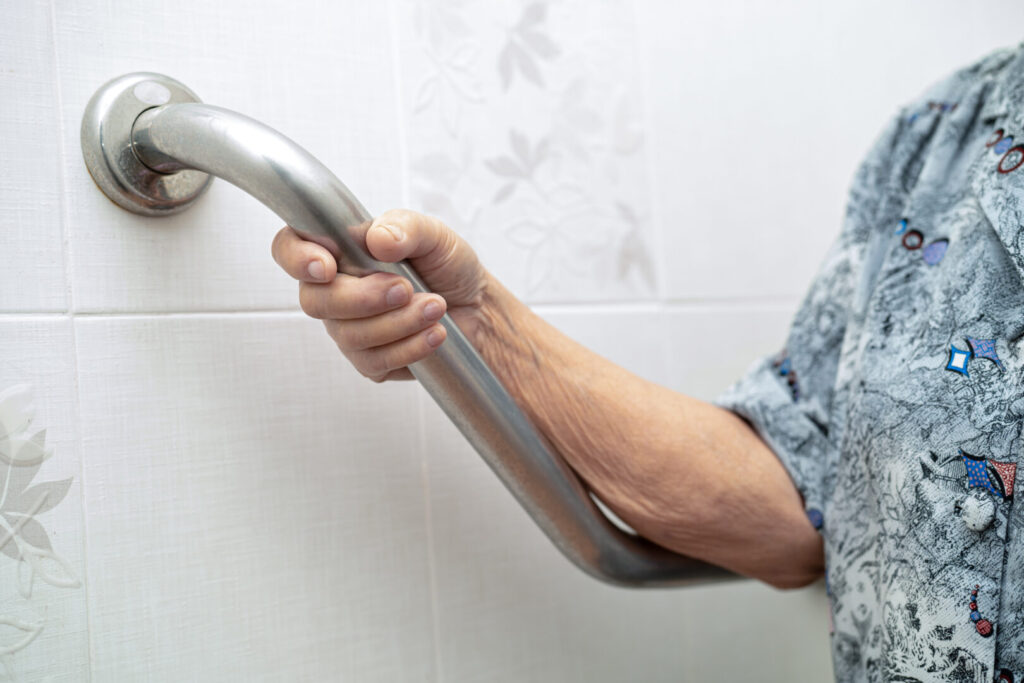As the golden years approach, it is imperative to pay close attention to the safety of the living environment. Home safety for seniors not only ensures a comfortable living space but also significantly reduces the risk of accidents and injuries.
With age, changes in physical abilities and health conditions necessitate modifications and precautions around the home. This blog explores essential home safety measures that are particularly important for seniors, encompassing fall prevention, bathroom and kitchen safety, home security, and fire safety.
By understanding and implementing these measures, we can foster a secure and accommodating home environment that empowers seniors to live independently and with dignity.
Fall Prevention
Falls can have serious consequences, especially for older adults. However, by implementing preventive measures, we can significantly reduce the risk of falls and create a safe environment for daily activities. Here are three essential strategies for fall prevention:
Removing tripping hazards
Identifying and removing potential tripping hazards is a crucial step in preventing falls. Take the following precautions to create a safe living space:
- Clear pathways: Keep walkways and hallways clear of clutter, electrical cords, and any other objects that obstruct movement.
- Secure rugs and mats: Use double-sided adhesive tape or non-slip backing to keep rugs and mats securely in place. Avoid using loose or wrinkled rugs that could cause trips.
- Arrange furniture carefully: Ensure furniture is arranged to provide clear paths and unobstructed movement. Remove low-lying furniture or rearrange it to minimize the risk of bumping into it.
Install handrails and grab bars
Installing handrails and grabbing bars in key areas of the home can provide essential support and stability, especially in areas prone to slips and falls. Consider the following suggestions:
- Stairways: Install sturdy handrails on both sides of the staircase to assist with balance and provide support when ascending or descending.
- Bathrooms: Install grab bars near the toilet, in the shower or bathtub area, and next to the sink. These bars can help with stability and provide leverage when maneuvering in the bathroom.
- Hallways: If necessary, install handrails along hallways or in areas where support is needed for walking longer distances.
Using non-slip mats
Non-slip mats play a vital role in fall prevention, particularly in areas that are prone to moisture or slippery surfaces. Consider the following recommendations:
- Bathrooms: Place non-slip mats on bathroom floors, both inside and outside the shower or bathtub. These mats provide traction and reduce the risk of slipping on wet surfaces.
- Entryways: Use non-slip mats near entrances, particularly during inclement weather. These mats help remove moisture from shoes and provide a secure footing.
- Kitchen: Place non-slip mats near sinks, dishwashers, and areas where spills are more likely to occur. This helps to prevent accidents while working in the kitchen.
Remember, a few simple adjustments can go a long way in promoting safety and preventing falls, allowing individuals to maintain their independence and enjoy life without unnecessary risks.
Bathroom Safety
The bathroom is a space that requires extra attention when it comes to safety. Slippery surfaces and hot water can pose risks for accidents and injuries. By implementing a few key strategies, we can enhance bathroom safety and create a secure environment for daily wellness.

Installing grab bars and non-slip mats
Installing sturdy grab bars in critical areas, such as near the toilet, bathtub, and shower, provides stability and support. These bars assist with sitting down, standing up, and maneuvering in wet conditions.
Additionally, placing non-slip mats on the bathroom floor, both inside and outside the shower or bathtub, helps prevent slips and falls by providing traction on wet surfaces.
Adjusting water temperature
Maintaining an appropriate water temperature is essential to prevent scalding and burns. Set the water heater thermostat to a maximum of 120 degrees Fahrenheit (49 degrees Celsius) to reduce the risk of accidental burns.
Before entering the shower or bathtub, always test the water temperature with your hand or elbow to ensure it is comfortable and not too hot. Consider installing anti-scald devices or thermostatic mixing valves in bathroom fixtures to regulate water temperature consistently and provide a safe bathing experience.
Kitchen Safety
The kitchen is a central hub in many homes, but it's also a place where accidents can easily happen. Let’s explore some straightforward ways to make kitchens safer by maintaining clear pathways, ensuring good lighting, and practicing safe cooking habits.
Clear pathways and good lighting
- Declutter: Keep countertops and floors free of clutter. Assign a designated space for each item to keep the kitchen organized and free of obstructions.
- Light It Up: Proper lighting is crucial. Ensure that countertops, stoves, and sink areas are well-lit. Consider under-cabinet lights for workspaces and good overhead lights for general visibility.
Safe cooking habits
- Smart Appliance Use: Follow manufacturer’s instructions for appliances and never leave them unattended. Regularly check them for proper functioning.
- Fire Safety: Keep a fire extinguisher within reach and ensure everyone knows how to use them. Stay alert for potential fire hazards and never leave cooking unattended.
- Knife Care: Use knives cautiously. Cut away from your body on a stable surface, and clean knives immediately after use.
- Food Safety: Wash hands and surfaces often, avoid cross-contamination of raw meats, cook foods to proper temperatures, and store them appropriately.
- Children and Pet Caution: Supervise children and pets, and keep them away from hot surfaces, sharp objects, and chemicals.
Home Security
Your home is your sanctuary, a place where you and your family should feel the safest. In this era, it is increasingly important to take proactive steps to ensure the security of your home. A combination of reliable locks, security systems, and motion sensor lights can go a long way in deterring potential intruders. This article delves into these components and how they contribute to bolstering home security.
Installing reliable locks and security systems
- Upgrading Locks: The first line of defense against intruders is having sturdy locks. Upgrading to high-security locks, which are more resistant to picking, bumping, and drilling, is a worthy investment. Deadbolt locks, particularly those with a grade 1 rating, provide an extra layer of security.
- Smart Locks: In addition to traditional locks, smart locks are an emerging trend. They allow you to control and monitor your locks remotely through a smartphone, often including features like keyless entry and automatic locking.
- Security Systems: A robust home security system is paramount. These systems usually comprise door and window sensors, high-decibel alarms, and a control panel. They can be monitored by a security company or through your smartphone. Opt for systems that offer real-time alerts and remote monitoring.
- Surveillance Cameras: Incorporate surveillance cameras into your security system. Position them at entry points, and ensure they are visible as they can be a deterrent for would-be intruders. Features like night vision and motion detection add extra layers of security.
Using motion sensor lights
- Deterrent Effect: Motion sensor lights are effective in deterring potential intruders. The sudden illumination when someone approaches can make intruders feel exposed and think twice before proceeding.
- Improved Visibility: These lights improve visibility for homeowners as well. Whether you’re returning home after dark or need to investigate a strange noise, having areas around your home automatically lit can provide both convenience and safety.
- Energy Efficiency and Customization: Motion sensor lights are energy-efficient as they only turn on when needed. Many models allow you to customize the range and sensitivity, ensuring that they’re triggered by significant movements rather than small animals or passing cars.
- Integration with Security Systems: Some motion sensor lights can be integrated with your security systems, where the activation of lights can also trigger cameras to record or send an alert to your phone.
Fire Safety
The well-being of your household is invaluable, and fire safety plays an indispensable role in safeguarding it. The combination of early warning systems and a well-devised escape strategy can drastically reduce the risk of fire-related incidents. This article will highlight the essential steps for maintaining smoke alarms and crafting an effective fire escape plan.
Maintaining smoke alarms
- Proper Placement: Position smoke alarms on every level of your home, including inside bedrooms and outside sleeping areas. High and central locations on ceilings are ideal, as smoke rises.
- Monthly Testing: Regularly test smoke alarms using the test button. Conduct this monthly to ensure that they are in good working condition.
- Changing Batteries: For alarms that are not hard-wired, replace batteries at least once a year. If an alarm “chirps,” indicating a low battery, replace it immediately.
- Scheduled Replacement: Smoke alarms don't last forever. Replace the entire unit every 10 years. Opt for units with a “replace-by” date for convenience.
- Regular Cleaning: Dust can obstruct a smoke alarm’s sensor. Vacuum or dust your smoke alarms regularly, following the manufacturer’s instructions.
- Interconnected Alarms: Interconnecting your alarms ensures that when one alarm sounds, they all do. This is crucial for larger homes where people might not hear an alarm from a distant room.
Having a fire escape plan
- Draft the Plan: Draw a map of your home and plot out multiple escape routes from each room. Make sure that doors and windows on the escape routes are easily accessible and unobstructed.
- Designate a Meeting Point: Establish a meeting point outside the house where everyone can gather after evacuating. This could be anything from a streetlight, or mailbox, to a neighbor's front yard.
- Regular Drills: Hold practice drills at least twice a year, varying the times and conditions (such as pretending some exits are blocked by fire) to simulate a real emergency.
- Special Needs Consideration: Assign a responsible person to help infants, elderly members, or anyone with mobility issues. Ensure that everyone in the household knows how to assist these individuals.
- Keep Communication Lines Open: Make sure everyone in the household knows the emergency number to call, and have a backup plan to alert other members of the household in case the primary escape route becomes blocked.
In conclusion, safeguarding seniors at home is critical and can be achieved through practical measures. Addressing fall risks, enhancing bathroom and kitchen safety, ensuring home security, and implementing fire safety protocols are key components. These efforts not only protect the elderly but also empower them with independence and peace of mind.





